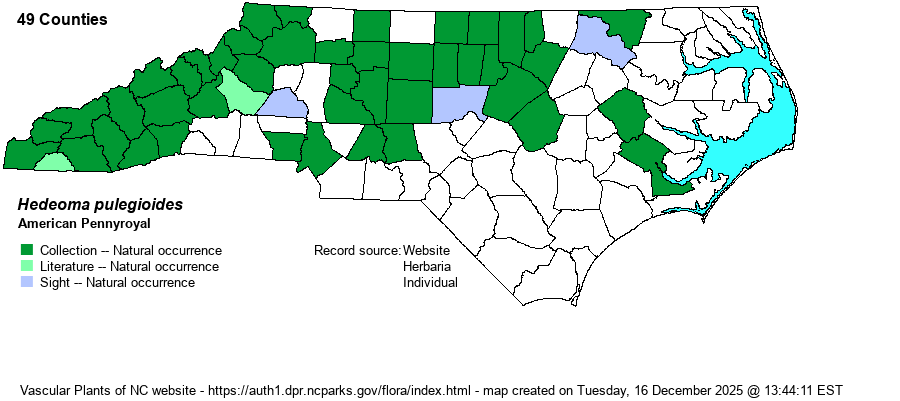| Author | (L.) Persoon | |
| Distribution | Throughout the Mountains, and nearly throughout the Piedmont, though apparently scarce in the southeastern portion. Ranges very rarely east to Northampton and Pitt counties into the northwestern Coastal Plain.
This is a widespread Eastern species, found in most counties within its range. Ranges from eastern Canada and IA south to central NC, central GA, and eastern OK.
| |
| Abundance | Has declined considerably over the past few decades, as RAB (1968) called it "common in mts. and pied.". Now, fairly common in the Mountains, uncommon to infrequent over the Piedmont, and very rare in the western edge of the Coastal Plain. Despite many references calling it common in the Eastern states, including formerly in NC, and currently in VA, it is by no means common in NC now, and the NCNHP's State Rank of S3? is not far off; the website editors rank it as S3S4, despite nearly 50 county records known. The decline is likely attributable to absence or scarcity of fire in maintaining its preferred habitats. | |
| Habitat | This is a species of dry soil in shaded to mostly shaded places, usually over high pH soil, partly explaining its relative "uncommonness" in much of NC. It occurs in rocky woods, glades and barrens, along trails and trail margins through upland woods, and in small openings in upland woods. | |
| Phenology | Blooms from late July into October, and fruits soon after flowering. | |
| Identification | This is a small and easily overlooked plant, typically branched from near the base, but growing only to about 10-12 inches high. It is a softly hairy plant, with an abundance of paired, opposite leaves, each elliptical to somewhat ovate but mostly 3/4-inch long and half as wide, entire to slightly serrate. When the leaves are broken, they are extremely fragrant with a mint-like smell. The very small flowers grow in the leaf axils, a few per axil, generally light blue but the corolla of about 1/5-inch long is partly hidden behind the green calyx. Thus, when in bloom you can still walk past a plant or a small group of plants without noticing; and, this species normally grow only in small groups and not in large colonies. You have to move slowly, and be very observant, when walking though upland woods to spot and then appreciate this plant. When found, it is always worth it to break off a leaf and take in the "minty" fragrance. It could be confused with a few exotic species in other genera; the very rare in NC Trichostema brachiatum has much longer leaves that are narrowly elliptic and entire, and the axillary flowers are brighter blue and are on pedicels and thus are not sessile. However, it also grows in dry, high pH soil. | |
| Taxonomic Comments | None
| |
| Other Common Name(s) | American False Pennyroyal | |
| State Rank | S3? [S3S4] | |
| Global Rank | G5 | |
| State Status | | |
| US Status | | |
| USACE-agcp | | |
| USACE-emp | | |

